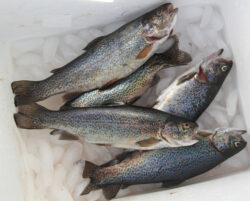Montana has been experiencing a decline in trout populations for the past few decades. There is not just one reason for trout declines. Brown trout in particular have seen recent declines. Also, Whitefish are seeing annual die offs. Here are some things that kill trout. 
DROUGHT No water, no fish or reproduction. Montana has seen over a decade of drought conditions. Low water also means less seasonal insects for fish to feed on. Surviving fish are more concentrated and share diseases more easily. Food is also in more demand. The Bighole River is seeing a 50 year low in population due to many of these issues.
TEMPERATURE Warmer water cooks fish. Once the water temperature exceeds 65 degrees, stress becomes an issue. Diseases accelerate in warmer temperatures. A water mold disease called Saprolegnia has become an issue since 2014.
DISEASES All trout share most diseases. When fish become stressed, their immune systems decline, and they get infected. Brown trout are susceptible to Furunculosis, and several parasites. Many Montana waters are infected with Whirling disease. Warmer and lower waters accelerate the spread of the parasites that cause disease. Parasites are released through the trout’s urine and spread. Some species are more vulnerable to one disease or another, but most trout become impacted. A new parasite caused kidney disease, Tetracapsuloiddes bryosalmonae, could also be to blame. Bucket Biology or illegal stocking can also be a problem.
AGE Trout are most vulnerable when young and old. Old age is 3-4 years in the trout world.
FLOODS and High-Water Dramatic changes in water flow and temperature impact fish wellness. Habitat is damaged, food washed away, and fish can be injured. Dramatic temperature change say from a Spring Runoff can put the fish into a state of shock. Trout fry also get sucked into irrigation headgates and ditches. When the ditches get shut down, so do the trout.
PREDATORS Pelicans, raptors, herons, larger fish, and other fish feeders feast on small fish. Out of 100 fry, maybe 3-6 will grow to an adult. When water is low, less habitat exists, and fish are more exposed and vulnerable.
CHEMICAL and TREATED Water Adding fertilizer, herbicides, and insecticides to watersheds can be a quick death. Too much nutrient can cause algae blooms and other impacts. Biologists are also currently adding chemicals like Rotenone to kill all fish in a watershed for restoration purposes. Keep in mind that most of our watersheds are also impacted from chemicals left over from mining, and natural geothermal pollution such as lead, mercury, and other toxins from the Earth.
CATCH and RELEASE Poor handling of fish by sportsmen are also an issue. Improper squeezing, wiping, lip ripping, and flopping into the boat or ground will all result in mortality. Trout can be caught several times but at some point, it becomes one too many. When the fish protective mucous is wiped off, fungus and disease are soon to follow.
GENETIC DECLINE The lack of genetic diversity can cause the gene pool to become too narrow or limited. New genetics may be needed as was the case in many Colorado fisheries. Many ‘Wild” trout are the result of past stocking with limited genetics.
POOR SPAWNING Low water, flow disruptions, and temperature fluctuations will add to mortality. The recent dam malfunction at Hegben Lake, along the Madison River is a perfect example. Over irrigation can also cause dewatering at the worst times when trout need cool water the most.
OVERPOPULATION When waters decline and warm, fish become congregated. More predations occur. Big fish eat little fish and there is less food. Disease can quickly spread.
STRESS Overfishing, harsh climate changes, and all the other mortality issues will stress a fishery. Just a few degrees of temperature change can impact fish wellness. Trout are slow to regulate their metabolism and decline quickly.
The truth is that our Wild and Native trout fisheries are susceptible to death by a thousand cuts. Fish decline is not the result of just one thing. Our Fishery Managers must look at all the issues that impact our fishery challenges and make educated and scientifically sound decisions to help them. It will take decades to fix, protect, and restore our trout fisheries.
Be a student of our sport and environment so we can all help. 
Montana Grant